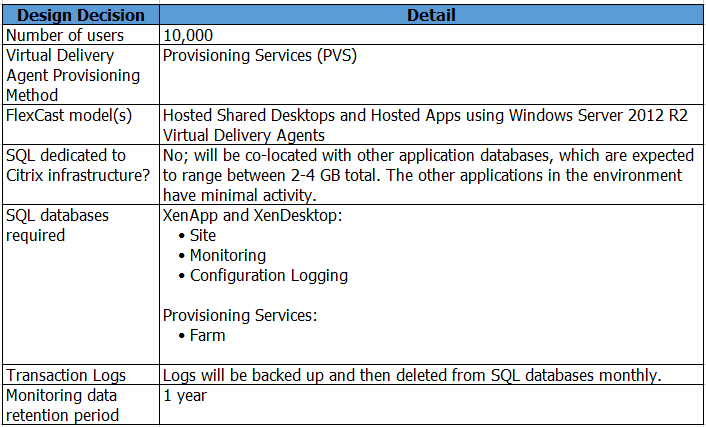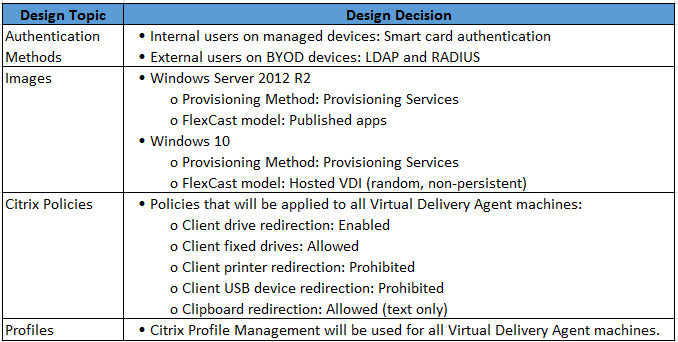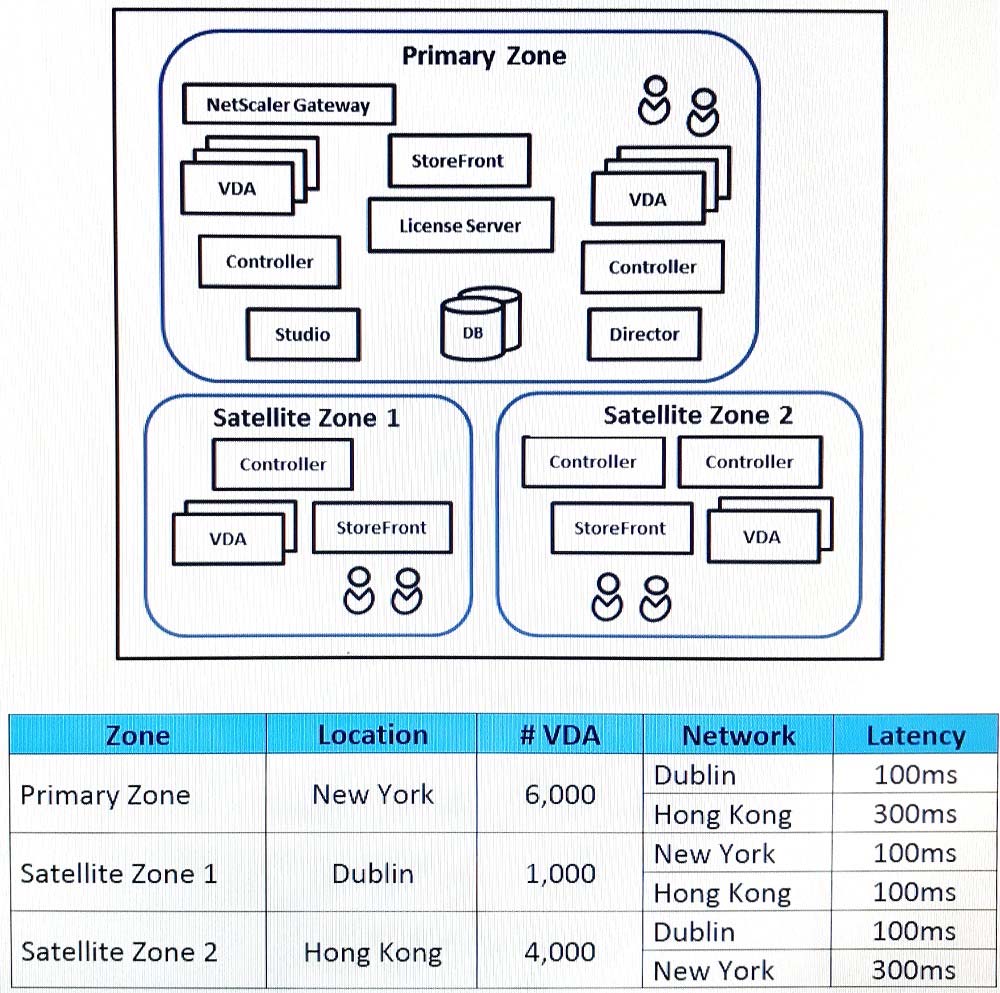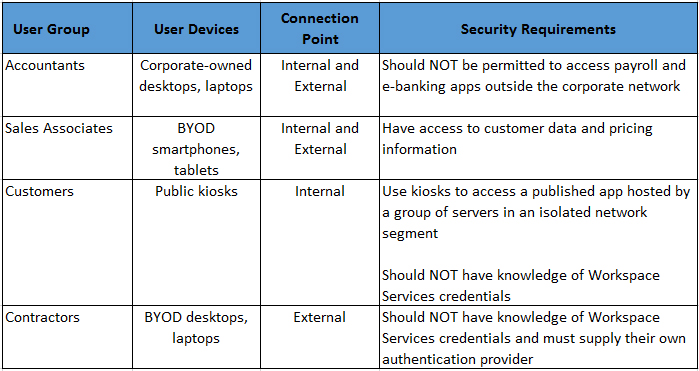Citrix XenApp and XenDesktop 7.15 Assessment, Design, and Advanced Configurations v1.0
Question 1
Scenario: A Citrix Architect needs to design a single-Site XenApp and XenDesktop environment. Through earlier design discussions, the architect has determined the environment details listed in the Exhibit.
Click the Exhibit button to view the details.

Which SQL server baseline specifications will provide acceptable performance and stability while avoiding unnecessary over-provisioning of resources?
- A. 4 CPU cores, 8 GB of RAM, 10 GB database storage
- B. 2 CPU cores, 4 GB of RAM, 10 GB database storage
- C. 2 CPU cores, 4 GB of RAM, 100 GB database storage
- D. 8 CPU cores, 16 GB of RAM, 10 GB database storage
- E. 8 CPU cores, 16 GB of RAM, 100 GB database storage
- F. 4 CPU cores, 8 GB of RAM, 100 GB database storage
Answer : F
Question 2
Scenario: While assessing the User Layer, a Citrix Architect finds that most of the internal users connect using corporate-owned laptops, desktop devices, and thin clients. Many of these laptops and desktop devices are running Windows 10, while the remainder of the machines are running Windows 7 and are in the process of being migrated to Windows 10. Some users also connect using personal devices.
Currently, Citrix Receiver is manually installed on any endpoint device added to the company. All these devices use Citrix Receiver version 4.8 and above. Some of the internal users with Windows laptops are experiencing issues in which devices such as a keyboard, mouse, a monitor connected to a docking station or a
USB hub are NOT usable in an HDX session.
Which action should the architect recommend to provide a uniform user experience for all users?
- A. Recreate user accounts in Active Directory
- B. Upgrade all clients to the latest version of Citrix Receiver
- C. Upgrade drivers of peripheral devices
- D. Recreate user profiles
Answer : B
Question 3
Scenario: A Citrix Architect needs to design a new XenApp and XenDesktop environment. Citrix Provisioning Services has been selected for image management.
Which two RAID levels should the architect use for the storage hosting the Provisioning Service write cache? (Choose two.)
- A. RAID 0
- B. RAID 1
- C. RAID 10
- D. RAID 6
- E. RAID 5
Answer : BC
Reference -
https://docs.citrix.com/en-us/xenapp-and-xendesktop/7-15-ltsr/citrix-vdi-best-practices/design/design-userlayer5.html
Question 4
Scenario: While assessing the User Layer, a Citrix Architect finds that most of the internal users connect using corporate-owned laptops, desktop devices, and thin clients. Many of these laptops and desktop devices are running Windows 10, while the remainder of the machines are running Windows 7 and are in the process of being migrated to Windows 10. Some users also connect using personal devices.
Currently, Citrix Receiver is manually installed on any endpoint device added to the company. All these devices use Citrix Receiver version 4.8 and above. The IT team is planning to automate a process to update all the devices with the latest version of Citrix Receiver and to automate another process for automatic installation of Citrix Receiver without incurring extra costs and maintenance.
What should the architect recommend to upgrade Citrix Receivers for internal Windows endpoints?
- A. The use of deployment tools for internal endpoints.
- B. The deployment of Enterprise software.
- C. Configure Receiver auto-updates through Citrix Cloud.
- D. Edit the Web.config file and set upgradeAtLogin to True.
Answer : A
Question 5
Scenario: A Citrix Architect needs to design a new XenApp and XenDesktop environment. The customer previously installed all applications locally on managed laptops and desktops but is willing to evaluate other application delivery methods as part of the new deployment. The environment will be standardized on
Windows 10 and Windows Server 2016 for the Virtual Delivery Agent (VDA) machines.
As part of an application analysis performed earlier in the project, the information shown in the Exhibit was collected regarding one of the required applications.
Click the Exhibit button to view the information.

Additionally, the customer has the following objectives:
-> Minimize the amount of additional infrastructure components.
-> Utilize thin clients as endpoints in order to reduce costs.
-> Users should NOT have direct access to the thin client operating system.
How should the architect install the application?
- A. Directly on a VDA machine image and accessed through a virtual desktop session
- B. On an Application Layer using Citrix App Layering and included in a layered image and accessed through a virtual desktop session
- C. Directly on endpoint devices and included in a virtual desktop session using the Local App Access feature
- D. Stream it to a VDA machine using Microsoft App-V and accessed through a virtual desktop session
- E. On an Application Layer using Citrix App Layering then presented to assigned users as an Elastic Layer during a virtual desktop session
Answer : B
Question 6
Scenario: A Citrix Architect is designing an environment for a large company. The company has identified the following user groups and requirements.
-> Product Managers - Typically, they work from inside the company network but are able to work from home. They need to use a variety of standard productivity and web-based SaaS applications.
-> Field Sales Engineers - They frequently work with mobile devices and tend to access the environment externally. They need access to sales tools and the front-end of the customer database.
-> Web Developers - Internal and remote workers who use specialized hardware with a graphics card to handle resource-intensive applications.
Which FlexCast model should the architect assign to Field Sales Engineers?
- A. Published Apps
- B. Hosted Applications
- C. Hosted VDI
- D. Published Desktops
Answer : B
Question 7
Scenario: A Citrix Architect is designing a XenDesktop environment. The Engineer group uses graphical applications which require the use of Intel Iris Pro GPUs.
Which two hypervisors can the architect select for this environment? (Choose two.)
- A. XenServer 6.5
- B. Microsoft Hyper-V Server 2012 R2
- C. XenServer 7.0
- D. VMware vSphere 5.5
- E. VMware vSphere 6.0
Answer : BE
Question 8
Scenario: A Citrix Architect needs to design a new XenApp and XenDesktop environment. The design will require three different StoreFront Stores and three corresponding Citrix Receiver for Web sites. Each different Store and Citrix Receiver for Web site will serve different business units. Each of these will also require their own branding and SSL certificate. The solution should remain supported by Citrix.
The architect has already installed StoreFront on a server.
How can the architect achieve the desired design while keeping cost and maintenance requirements as low as possible?
- A. Create two extra IIS Sites, bind the certificates in IIS manager, copy the StoreFront configurations to the two new IIS Sites, and use a text editor to configure all three StoreFront Stores.
- B. Deploy two extra virtual servers, bind the certificates in IIS manager, and install StoreFront again on each new virtual server.
- C. Create two extra IIS Sites, bind the certificates in IIS manager, copy the StoreFront configuration to the two new IIS Sites, and use the StoreFront console to configure all three StoreFront Stores.
- D. Create two extra IIS Sites, bind the certificates in IIS manager, use PowerShell to deploy additional Stores to the two new IIS Sites, and use a text editor to configure all three StoreFront Stores.
Answer : C
Question 9
Scenario: A Citrix Architect has designed an active/passive XenApp and XenDesktop environment for a customer, where the passive datacenter serves as the disaster recovery datacenter for all users.
The following has been configured:
-> NetScaler Global Server Load Balancing (GSLB) to provide single URL direction to the active datacenter.
-> GSLB has health monitors configured for the load balanced servers.
-> NetScaler Gateways are on both datacenters.
-> NetScaler load balancing occurs for StoreFront and Delivery Controller XML services.
-> A single XenApp and XenDesktop Site exists.
-> Four Delivery Controllers are members of the Site.
-> Two Delivery Controllers are members of the primary zone in the active datacenter.
-> Two Delivery Controllers are members of the satellite zone in the passive datacenter.
-> SQL is deployed in the active datacenter.
-> Local Host Cache is enabled.
Two StoreFront servers are deployed in each datacenter aggregating resources from the Delivery Controllers in the respective datacenter.

-> Virtual Delivery Agent (VDA) machines are deployed in both datacenters and configured to register with Delivery Controllers in their zone.
What would happen if the SQL Server in the primary datacenter were turned off?
- A. VDA machines from the primary datacenter would register with the Delivery Controllers in the passive datacenter.
- B. GSLB will NOT identify that the SQL Server is down and sessions cannot launch.
- C. StoreFront in the primary datacenter would still be able to launch sessions.
- D. GSLB will start redirecting connections to the secondary datacenter.
Answer : A
Question 10
Scenario: A large retail environment includes a StoreFront server group with two servers, each with 2 vCPUs and 4 GB of RAM. The server group handles about
25,000 user connections per hour, with a majority of the users accessing the environment using native Receiver. Workspace Control has been disabled for the environment.
A Citrix Architect learns that the company will soon merge with another retail chain. The XenApp and XenDesktop environment must double its capacity, and the
StoreFront server group is expected to handle about 40,000 user connections per hour.
What should the architect do to meet the expected load while maintaining high availability with optimal resource allocation for the StoreFront component?
- A. Add a third StoreFront server with 2 vCPUs and 4 GB of RAM.
- B. Allocate an additional 2 vCPUs to each existing StoreFront server.
- C. Train users to begin accessing the environment using Receiver for Web.
- D. Allocate an additional 2 GB of RAM to each existing StoreFront server.
- E. Enable Workspace Control for all StoreFront stores.
Answer : E
Question 11
Scenario: A Citrix Architect needs to design a new XenApp and XenDesktop environment for a bank. After the project kickoff meeting, the following business drivers have been identified and prioritized in the following order:
1. Increase security
2. Reduce costs
3. Improve the user experience
4. Simplify management
Later in the design process, the architect documents the design decisions shown in the Exhibit (only some are shown).
Click the Exhibit button to view the design decisions.

During the quality assurance review, the architect observes that one of these design decisions does NOT align with the business driver priorities.
Which design decision should be changed to match the prioritization of the business drivers?
- A. Images
- B. Profiles
- C. Authentication Methods
- D. Citrix Policies
Answer : D
Question 12
Scenario: A Citrix Architect needs to assess a XenApp and XenDesktop environment. The XenApp and XenDesktop diagram in the Exhibit gives details about the current Site and Zone design.
Click the Exhibit button to view the diagram.

What should the architect recommend based on the current Site and Zone design?
- A. Add an additional Delivery Controller to the Primary Zone.
- B. Replace Satellite Zone 2 with a separate XenDesktop Site.
- C. Add additional StoreFront servers to Satellite Zone 2.
- D. Replicate the XenDesktop Site database to Satellite Zone 2.
Answer : A
Question 13
Scenario: A Citrix Architect needs to design a new XenApp and XenDesktop environment.
The architect has identified the User Layer requirements, as shown in the Exhibit.
Click the Exhibit button to view the requirements.

Additionally, management at the organization has identified the following general Access Layer requirements:
-> A multi-factor authentication method is required for any connections to the XenApp and XenDesktop environment originating from outside the corporate network.
-> External connections must be authenticated by a NetScaler Gateway virtual server located in a DMZ network.
-> Internal connection traffic should NOT leave the internal corporate network.
Which Access Layer feature should the architect configure to meet the security requirements of the Accountants group?
- A. SmartControl
- B. Endpoint analysis scan
- C. SmartAccess
- D. Federated Authentication Service
Answer : A
Question 14
Scenario: A Citrix Architect needs to implement a new XenDesktop environment for an engineering company. The IT department has purchased 1,000
XenDesktop Enterprise licenses. They will deploy Microsoft Office productivity applications to all users. Users access XenApp sessions from company offices using thin client devices and remotely through NetScaler Gateway using personal devices.
The company requires IT to produce a report of all XenApp connection failures for the previous year.
Which two actions does the architect need to take to support these requirements? (Choose two.)
- A. Purchase XenDesktop Platinum licenses.
- B. Purchase NetScaler Gateway Universal licenses.
- C. Configure GroomSessionsRetentionDays to 365 days.
- D. Implement NetScaler Management and Analytics System (MAS).
- E. Configure GroomFailuresRetentionDays to 365 days.
Answer : AD
Question 15
Scenario: The IT team of a company needs to migrate to Microsoft Azure and has asked a Citrix Architect for a solution that offers protection from datacenter level failures.
What should the architect recommend the IT team create in Microsoft Azure?
- A. Availability set with update domain
- B. Availability set with fault domain
- C. Resource group
- D. Availability zones
Answer : D
Reference -
https://docs.microsoft.com/en-us/azure/virtual-machines/windows/manage-availability